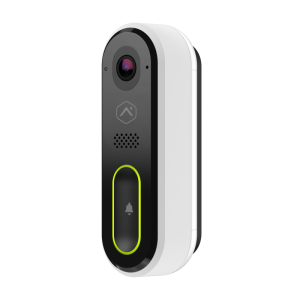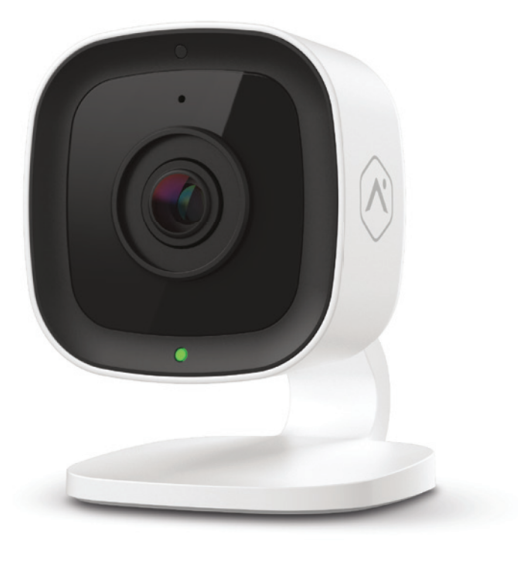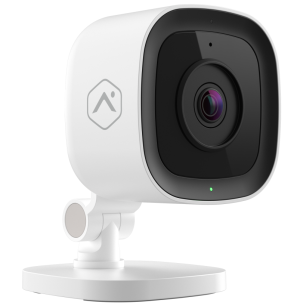If you have Alarm.com Video Surveillance service, then you likely know that the lineup of compatible security cameras is quite deep. It can be a bit daunting to decide which camera is best for you. Today, we're going to present our list of our Top 5 Best Alarm.com Cameras for use at home.

Keep in mind that we're not presenting any "commercial" cameras on the list. Only residential cameras will be considered. You can usually tell the difference based on the name. The Alarm.com Commercial Cameras will have a "VC" somewhere in the title, whereas the Alarm.com Residential Cameras only have a "V" in the title. We also considered Alarm.com Doorbell Cameras for this list, and those can be identified by having "VDB" for "Video Door Bell", in the name. Other than that, there's really not much else to think about. These are just the residential cameras that we think are most useful. We also want to mention that every camera on this list is compatible with Alarm.com Video Analytics, to at least some degree. If you aren't familiar with Alarm.com Video Analytics, we recommend checking out this FAQ to learn more. With that out of the way, let's get started!
5. Alarm.com ADC-V515 Budget Indoor Camera
The ADC-V515 is often seen as the "budget version" for another camera higher on this list. But despite being a low-cost option, the ADC-V515 still packs some impressive features. It offers 1080p recording capabilities, IR night vision of up to 15 feet, a 110° viewing angle, a nice 3.19mm F2.2 lens, and WIFI connectivity (2.4 GHz networks only). If that weren't enough, the ADC-V515 even offers High Dynamic Range (HDR) to make recordings appear deeper and more luminous. The camera might feel a bit more "flimsy" compared with the other models on this list, but still, it has the strong quality to keep your home safe for a very long time. This is a great starter camera for those who want to get into video surveillance, without breaking the bank.
Best For: Anyone needing a great indoor-only camera on a budget.
 4. Alarm.com ADC-V622-WELL Wellness Camera
4. Alarm.com ADC-V622-WELL Wellness Camera
While it's specifically designed for monitoring an elderly or mobility challenged loved one and helping them live independently, the ADC-V622-WELL, also called the Alarm.com Wellcam, actually boasts some excellent security capabilities as well. This is a camera tower that can be easily mounted to a wall or conveniently placed on a table or desk. In addition to its 1080p recording quality, 1.62mm F2.3 lens, and IR night vision of up to 15 feet, the Wellcam is perhaps best known for its "press to call" feature and its two-way audio capability. This is also the only camera on this list that supports Power over Ethernet (PoE), which is usually reserved for commercial cameras. However, you might feel a bit silly buying this camera for strictly security purposes, as the packaging really emphasizes the "wellness" aspect.
Best For: Anyone needing to monitor a family member to help them live independently.

3. Alarm.com ADC-VDB770 Doorbell Camera
When it comes to doorbell cameras, Alarm.com has no shortage of options. But few would argue that the ADC-VDB770 isn't the single best doorbell camera offering from Alarm.com. In fact, many would say that it's the single best video doorbell on the market, period. This incredible device offers resolution of up to 1440x1920 Full HD, a Field of View of 150° Vertical and 115° Horizontal, IR night vision of up to 15 feet, and two-way voice for communicating with whomever is at your door. If that weren't enough, the doorbell camera even offers HDR recording, a feature normally reserved for traditional HD cameras. It is worth mentioning that unlike the other cameras on this list that support the full range of Alarm.com Video Analytics, the ADC-VDB770 only supports limited range of Video Analytics, in which only one (1) Ground Zone rule can be configured. But for a video doorbell, that's usually all you will need. Best of all, while this camera still counts towards your total ADC camera limit, you can actually use a single video doorbell device like the ADC-VDB770, on your Alarm.com account, even if you don't have a traditional video monitoring plan. This makes the device fantastic for monitoring your home's primary entrance, without needing to upgrade to a higher-cost monitoring plan.
Best For: Those wanting a top-of-the-line doorbell camera to integrate with Alarm.com.
 2. Alarm.com ADC-V523 Premium Indoor Camera
2. Alarm.com ADC-V523 Premium Indoor Camera
When we said earlier that the ADC-V515 was the "budget" version of another camera on this list, the ADC-V523 is that camera. This is considered the standard "go-to" camera for use with Alarm.com. Any residential user who is just looking for a great, all-around camera for general use should absolutely consider the ADC-V523. It is basically everything that the ADC-V515 offers, but better. The lens is boosted to 3.0mm F2.0, the viewing angle has been increased to 117°, and you can connect with both 2.4 GHz and 5 GHz WIFI networks. Even the build quality is improved, as the ADC-V523 has a heavier feel to it, and you can quickly identify that this is the premium offering from Alarm.com. Also returning to the ADC-V523 is the 1080p Full HD recording quality and HDR recording for deeper-looking footage. The only weakness with regard to this camera is that it cannot be used outside. It's for indoor use only.
Best For: Anyone needing the very best residential Alarm.com Camera for strictly indoor use.
 1. Alarm.com ADC-V723 Premium Outdoor Camera
1. Alarm.com ADC-V723 Premium Outdoor Camera
The ADC-V723 eliminates the most glaring drawback of the ADC-V523, as our top Alarm.com Camera pick can be used both indoors and outdoors. For the most part, the ADC-V723 offers the same specifications as the ADC-V523, but there are a few improvements. Returning to the ADC-V723 from the ADC-V523 is the 3.0mm F2.0 Lens, the 117° Viewing Angle, Full HD recording with HDR for more luminous footage, and the full suite of Alarm.com Video Analytics. But the ADC-V723 offers a few unique upgrades in its own right. This camera introduces ingress protection (IP66) for keeping out the harsh outside elements. It also offers further IR night vision of up to 40 feet, so that individuals standing even further away can still be properly identified in nighttime recordings. It's safe to say that the ADC-V723 is basically the same as the ADC-V523, only better. But the "upgrades" really only come in handy if you need an outdoor camera. If you intend on keeping the ADC-V723 tucked inside, then you may as well just get the ADC-V523. When used indoors though, the two cameras have to be considered equal. In this case, we have to give the ADC-V723 the edge for its ability to function as an outdoor camera.
Best For: Anyone needing the very best outdoor camera for use with Alarm.com.
 Do you agree with our list? Do you have any of these cameras at your house? Maybe some of these cameras are on your wish list? Let us know in a comment down below. Remember that you need an alarm monitoring plan with video surveillance, such as an Alarm Grid Platinum Plan or Video-Only Plan, to get started with most of these cameras. The only exception is the ADC-VDB770, as you can add a single compatible video doorbell device to an existing Alarm.com account, without a true video surveillance plan. If you need help getting started with any of these cameras, please email our team at suppor@alarmgrid.com. We're here to check incoming emails from 9am to 8pm ET M-F. Also don't forget to comment down below, and stay tuned to the Alarm Grid Blog for more content coming real soon!
Do you agree with our list? Do you have any of these cameras at your house? Maybe some of these cameras are on your wish list? Let us know in a comment down below. Remember that you need an alarm monitoring plan with video surveillance, such as an Alarm Grid Platinum Plan or Video-Only Plan, to get started with most of these cameras. The only exception is the ADC-VDB770, as you can add a single compatible video doorbell device to an existing Alarm.com account, without a true video surveillance plan. If you need help getting started with any of these cameras, please email our team at suppor@alarmgrid.com. We're here to check incoming emails from 9am to 8pm ET M-F. Also don't forget to comment down below, and stay tuned to the Alarm Grid Blog for more content coming real soon!





 This is another example of how Alarm.com continues to innovate within the video surveillance space. Particularly when outdoor cameras are used, this feature can go a long way toward not just notifying of a break-in, but discouraging one. For Alarm Grid customers, you will need either our
This is another example of how Alarm.com continues to innovate within the video surveillance space. Particularly when outdoor cameras are used, this feature can go a long way toward not just notifying of a break-in, but discouraging one. For Alarm Grid customers, you will need either our 



 1.
1. 





